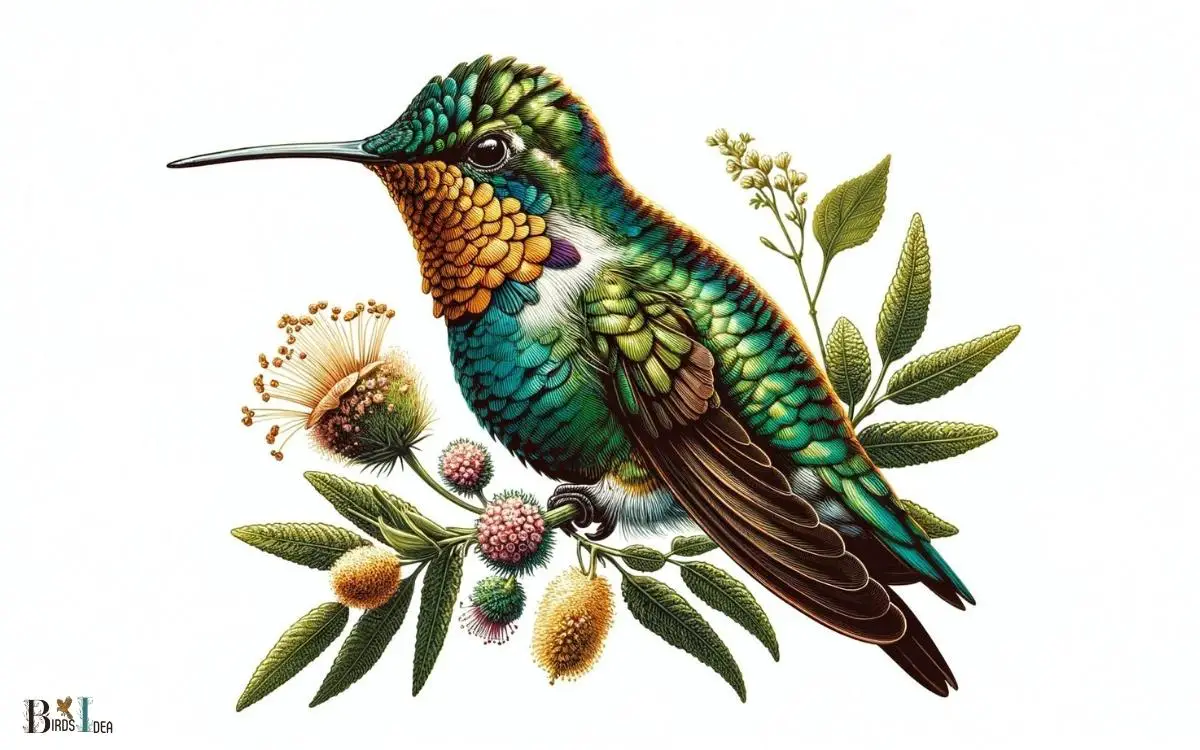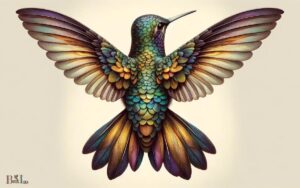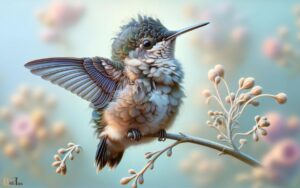What Does a Bee Hummingbird Look Like? Smallest!
The Bee Hummingbird is the smallest bird in the world, measuring about just 2.25 inches in length and weighing around 0.07 ounces.
Males have iridescent plumage with vibrant colors like turquoise and fiery red, while females have a more subdued coloration.
They possess a slender, needle-like bill for feeding on nectar, and their wings can beat incredibly fast, allowing them to hover in mid-air.
Despite their small size, they are agile fliers and can cover a wide range of territory in search of food. Their diminutive size and striking appearance make them a fascinating species to observe.

Key Takeaway
Size and Proportion
To understand the size and proportion of a bee hummingbird, look at it from a close distance.
- This incredible creature, found primarily in Cuba and the Isla de la Juventud, is the smallest bird in the world.
- With an average length of just 2.25 inches and weighing around 0.07 ounces, it’s truly a marvel of nature.
- The bee hummingbird’s body is compact and streamlined, ideal for its rapid flight and quick movements.
- Its wings, measuring around 1.25 inches, allow it to hover effortlessly, resembling the flight of a bee.
- Despite its diminutive size, the bee hummingbird displays remarkable agility and strength.
- Its long, needle-like beak is perfectly adapted for reaching nectar deep within flowers, and its vibrant plumage shimmers in the sunlight, showcasing its freedom and beauty in the natural world.
Plumage and Coloration
Take a closer look at the bee hummingbird’s plumage and coloration to appreciate its stunning beauty.
- This tiny bird boasts vibrant and iridescent feathers that shimmer in the sunlight.
- The male bee hummingbird is adorned with a brilliant combination of blues and greens on its upperparts, while its underparts exhibit a striking, fiery red color.
- The feathers on its head and throat form a velvety black cap, which contrasts elegantly with its iridescent gorget, displaying a range of vivid colors when viewed from different angles.
- In contrast, the female bee hummingbird showcases more muted tones, with greenish upperparts and a pale grayish underbelly.
- The intricate patterns and hues of the bee hummingbird’s plumage are a true marvel of nature, captivating viewers with their exquisite beauty.
Beak and Tongue Structure
The beak and tongue structure of the Bee Hummingbird is a marvel of adaptation for nectar consumption.
The beak is long and slender, perfectly suited for reaching deep into flowers to extract the sweet nectar.
The tongue is extensible and forked, allowing the bird to lap up nectar from the deepest parts of the flower.
These specialized structures not only enable the bird to feed on nectar but also play a crucial role in the pollination process as they come into contact with the flower’s reproductive organs.
Adaptations for Nectar Consumption
With its unique adaptations for nectar consumption, the Bee Hummingbird’s beak and tongue structure allow for efficient feeding.
The beak of the Bee Hummingbird is long and slender, perfectly suited for reaching deep into flowers to extract nectar.
Its tongue is a marvel of nature. The tongue of the Bee Hummingbird is long and split at the end, resembling a delicate brush.
This adaptation allows the bird to lap up nectar from the flowers by rapidly extending and retracting its tongue.
The Common adaptations of the Bee Hummingbird’s beak and tongue structure
| Beak Structure | Tongue Structure |
|---|---|
| Long and slender | Long and split |
| Allows for reaching deep into flowers | Rapid extension and retraction |
| Perfect for extracting nectar | Enables lapping up nectar |
These unique adaptations of the Bee Hummingbird’s beak and tongue structure are vital for its survival, ensuring it can efficiently consume the nectar it needs to fuel its tiny but powerful body.
Role in Pollination Process
Now, let’s delve into how your Bee Hummingbird’s beak and tongue structure play a crucial role in the pollination process.
- The beak of the Bee Hummingbird is long and slender, perfectly adapted to reach deep into the flowers. Its shape allows it to extract nectar from the base of the flower, where the sweet reward is often hidden.
- The hummingbird’s tongue is uniquely designed to collect nectar efficiently. It’s long and split at the tip, forming two tubes. This allows the bird to submerge its tongue deep into the flower and lap up the nectar.
- As the hummingbird visits various flowers in search of nectar, it unintentionally collects and transfers pollen from one flower to another, facilitating cross-pollination.
- The specialized beak and tongue structure of the Bee Hummingbird make it a vital pollinator, contributing to the diversity and survival of many plant species.
Wing Shape and Movement
The wings of a Bee Hummingbird are a marvel of nature, finely crafted for swift and agile flight. They’re small and compact, perfectly suited to the bird’s diminutive size.
As the Bee Hummingbird hovers near a flower, its wings move in a unique pattern, creating a blur of motion that allows it to maintain stability and precision in its movements.
Bee Hummingbird Wings
To see how a bee hummingbird’s wings move, observe them in flight.
- The wings of a bee hummingbird are a marvel of nature’s engineering. They’re long and narrow, with a unique shape that enables the bird to hover in mid-air.
- As the hummingbird hovers, its wings move in a figure-eight pattern, beating at an incredible rate of up to 80 times per second.
- This rapid wing movement creates a humming sound, which gives the bird its name. The wings of a bee hummingbird are also incredibly flexible, allowing the bird to change direction quickly and maneuver through tight spaces.
It’s truly a sight to behold, watching these tiny birds dart and hover with such grace and agility.
Swift and Agile
Observe the bee hummingbird’s swift and agile wing shape and movement as it hovers in mid-air. Its wings are long and narrow, resembling tiny blades that cut through the air effortlessly.
The scientific term for this wing shape is ‘elliptical,’ which allows for rapid, precise movements. As the hummingbird hovers, its wings beat at an astonishing rate of 80 times per second, creating a blur of motion.
The flexibility of its wings enables it to change direction swiftly, darting from one flower to another with remarkable agility. Its flight pattern is unpredictable, as it can fly backwards, sideways, and even upside down.
This adaptation allows the bee hummingbird the freedom to access nectar from various angles, ensuring its survival in its natural habitat.
Unique Flight Patterns
- The wing shape and movement of a bee hummingbird play a crucial role in its ability to perform extraordinary flight maneuvers.
- With their small size and rapid wing beats, bee hummingbirds can hover in mid-air, fly forwards, backwards, and sideways, and even perform acrobatic aerial displays.
- The wings of these tiny birds are long and narrow, allowing for quick and agile movements.
- They have a high aspect ratio, meaning their wings are relatively long and slim compared to their width.
- This shape helps to reduce air resistance and increase maneuverability.
- The wings of a bee hummingbird move in a figure-eight pattern, creating lift on both the upstroke and downstroke, enabling them to hover effortlessly and change direction rapidly.
The combination of their unique wing shape and movement allows bee hummingbirds to navigate through dense vegetation, feed on nectar from flowers while in mid-air, and even chase away larger birds.
This exceptional flight ability gives them the freedom to access food sources that are inaccessible to other birds, making them highly efficient and successful pollinators.
So, next time you see a bee hummingbird darting around with its wings moving in a blur, remember that it is their specialized flight patterns that enable them to perform such remarkable aerial feats.
Tail Feathers and Display
You can easily spot the tail feathers and display of a bee hummingbird.
- The tail feathers of the male bee hummingbird are a key feature that sets it apart from other species. These feathers are long and tapered, creating a sleek and streamlined appearance.
- During courtship displays, the male bee hummingbird uses its tail feathers to perform intricate aerial maneuvers.
- It hovers in mid-air, rapidly beating its wings while its tail feathers fan out, creating a vibrant display of colors.
- The iridescent feathers on the male’s tail catch the sunlight, producing a mesmerizing effect. This elaborate display is performed to attract and impress potential mates.
Now, let’s move on to the next section to explore the physical adaptations that allow bee hummingbirds to excel in flight.
Are Bee Hummingbirds the Smallest Hummingbirds?
The hummingbird feet appearance can vary among different species, but when it comes to size, the Bee Hummingbird takes the crown as the smallest. Native to Cuba, these incredible birds measure only about 2.25 inches long and weigh less than 2 grams. Their tiny feet allow them to navigate their surroundings with exceptional agility and grace.
Physical Adaptations for Flight
To understand the physical adaptations for flight in a bee hummingbird, take a closer look at its remarkable anatomy.
- With its small body size and rapid wingbeats, the bee hummingbird has evolved several unique features to optimize its flight capabilities.
- Firstly, its wings are long and narrow, allowing for efficient lift and propulsion.The bird’s pectoral muscles, responsible for powering the wings, are highly developed and efficient, enabling rapid and sustained flight.
- The bee hummingbird possesses a highly specialized respiratory system, with a high metabolic rate and efficient oxygen utilization for energy production during flight.
These physical adaptations enable the bee hummingbird to hover, fly backwards, and perform acrobatic maneuvers with ease.
Conclusion
As you observe the wondrous bee hummingbird, its diminutive size and vibrant plumage captivate your senses.
Its delicate beak and long, delicate tongue are perfectly adapted for sipping nectar from tiny flowers.
The rapid flutter of its wings creates a blur of motion, allowing it to hover effortlessly in mid-air.
And oh, the display of its iridescent tail feathers, shimmering like a precious gem in the sunlight.
Truly, the bee hummingbird is a marvel of nature, a stunning example of the intricate beauty that exists in our world.





